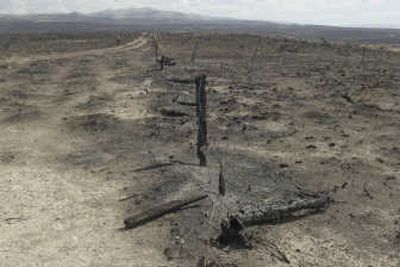Plan to restore land OK’d

BOISE – Federal land managers have approved a four-year, $23 million plan to restore high desert in Idaho and Nevada burned by this year’s largest wildfire, the Murphy Complex, which destroyed more than 1,000 square miles of sage- and grassland needed for wildlife and cattle.
One environmental group that’s opposed to grazing public land said this week it could sue over provisions that call for restoring fencing for cows.
In approving the plan, Bureau of Land Management officials in Washington, D.C., immediately set aside $11.4 million to be spent this year, most to go toward buying grass seed to replant an area larger than Rhode Island.
State and federal biologists studying damage to prime sage grouse habitat have concluded the flames destroyed about 75 grouse mating grounds. In addition, ranchers whose families have grazed cattle on BLM territory in the high country along the Idaho-Nevada border for more than a century lost valuable forage the agency hopes to replace.
“These are immediate efforts to control soil erosion and fight noxious weeds,” Barry Rose, a BLM spokesman in Boise, said Tuesday.
He said the agency wants to prevent exposed soil from washing away in the fall rains and to seed the burned area with native and introduced grasses to avoid further spread of invasive species such as cheatgrass that has been blamed for exacerbating this year’s blazes.
The restoration plan was approved Friday in Washington, D.C., and made public this week.
The Murphy Complex started July 16, as 2,600 dry lightning strikes hit along the border. The fire was contained in early August at a cost of about $9.5 million.
As part of the emergency stabilization plan, $473,000 will be spent on so-called “protective fencing” meant to keep livestock out of damaged areas.
In all, the BLM aims to spend more than $9 million on protective fencing and repairs to permanent fences that divide cattle grazing allotments.
Jon Marvel, director of the Hailey, Idaho-based Western Watersheds Project, said he could still sue in federal court to stop the fence-building plan. His organization aims to end all grazing on public land in the Rocky Mountain West on grounds it has irretrievably harmed the landscape.
“A great deal of money is proposed to be spent on replacing fences that were burned,” Marvel said. “We think the funding would be better spent on restoring native vegetation, rather than initially on fencing. We have proposed, among other things, that no temporary fencing be built. Fencing of any kind interferes with wildlife migration and can be fatal to sage grouse.”
In addition to federal efforts, Idaho officials announced earlier this week their own effort to restore state-managed land burned by the Murphy Complex fires. For instance, Idaho Department of Correction prisoners are making new hoppers to be worn by volunteers this November to collect thousands of pounds of sagebrush seeds.
“This was a particularly huge fire year. Forest fires have been burning since the first of July,” said Mary Dudley, the Idaho Department of Fish and Game’s volunteer coordinator of the seed collection program. “Nevertheless, we have done plantings and seedings before where I can see the difference.”